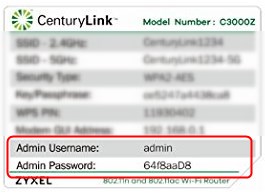CONTENTS
Brief overview
This CenturyLink router login guide will show you the exact steps needed to login to your CenturyLink router. When you access the router settings you will be able to secure your home network or update the firmware to the latest version. Of course, there are many other options you can change here but in order to do all of that you need to login to the router first. Let’s see how to do it.
How to login to your Century router?
STEP 1: Connect to the network via WiFi or the network cable
Why is this important? Well, you won’t be able to login to your Century link router using a device that is not connected to the network. Only devices connected to the network can login to the router. Other devices that are not connected can’t access the router. To connect you can use a wireless connection if you know the network name and WiFi password, or preferably, connect the device to the network using a network cable.
STEP 2: Launch your favorite browser
The CenturyLink router settings can be accessed using a web browser. When we do that, we are not connecting to a website but to the router’s Web GUI and therefore we don’t need to be connected to the internet.
STEP 3: Type the default CenturyLink router IP in the browser’s URL bar
Type the CenturyLink default IP http://192.168.0.1 in the browser’s URL bar.
STEP 4: Enter the CenturyLink router login username and password

When asked to enter a username and password you can type the ones found on the sticker on your router.
You can use these login details if you haven’t changed them before. In case you have changed them, use the custom ones to login to the CenturyLink router.
NOTE: The router username and password are not the SSID and the Key/Passphrase, so pay attention. You need to use the Admin username and Admin password.
After you click the Apply button you should see the CenturyLink router Web GUI. It is easy to find the setting you need to change like the WiFi name and password.
How to change the CenturyLink router login password
The Admin password is there to prevent anyone from accessing the router settings. Most people don’t bother changing it but it is generally a good security measure to change it into something more memorable.
After you login to the router, click the Advanced setup button.
Now, in the left-hand menu go to Security and click on Administrator Password.
- Click the Enable checkbox.
- Enter the new administrator username and password. Type it again to confirm you have entered it correctly.
- Click the Apply button to save the changes.
When you change the Admin password make sure to write it down for the next time you are going to need it. In case you lose the custom password you will need to reset the router to factory settings in order to access the CenturyLink settings again.
Important notes:
- Make sure to type the default IP correctly. Often typing the letter “O” instead of the number zero “0” will result in an error.
- Always type the default IP in the browser’ s URL bar (Address bar). Typing the IP in Google search won’t trigger the CenturyLink login page to open.
- The Admin password is case sensitive so type it carefully.
Final Thoughts
Just like with any other router the CenturyLink router login steps are easy and straightforward. However, to do it properly and successfully you need to be connected to the network, and you need to know the default router IP, 192.168.0.1 in this case and the admin username and password that can be found on a sticker on the router.

Hey, I’m David. I’ve been working as a wireless network engineer and a network administrator for 15 years. During my studies, I also worked as an ISP field technician – that’s when I met Jeremy.
I hold a bachelor’s degree in network engineering and a master’s degree in computer science and engineering. I’m also a Cisco-certified service provider.
In my professional career, I worked for router/modem manufacturers and internet providers. I like to think that I’m good at explaining network-related issues in simple terms. That’s exactly what I’m doing on this website – I’m making simple and easy-to-follow guides on how to install, set up, and troubleshoot your networking hardware. I also review new network equipment – modems, gateways, switches, routers, extenders, mesh systems, cables, etc.
My goal is to help regular users with their everyday network issues, educate them, and make them less scared of their equipment. In my articles, you can find tips on what to look for when buying new networking hardware, and how to adjust your network settings to get the most out of your wi-fi.
Since my work is closely related to computers, servers, and other network equipment, I like to spend most of my spare time outdoors. When I want to blow off some steam, I like to ride my bike. I also love hiking and swimming. When I need to calm down and clear my mind, my go-to activity is fishing.
